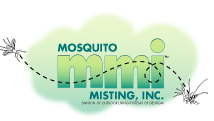Natural Pyrethrum Based Insecticides
How do the pyrethrums work?
Physiologically, the pyrethrums inhibit the mosquito’s desire to bite. It also repels the mosquitoes when they enter an area that contains trace amounts of the mist. When the mosquito contacts the mist, it immediately exhibits erratic flight and behavior, followed by paralysis, and finally death. With the addition of a PBO (synergist which has little or no insecticidal action by itself), the effects of the pyrethrum are multiplied. The insect’s immune system (detoxifying enzymes called MFO’s) could, if given time and the right conditions for recovery, counteract the effect of small doses of pyrethrum. However, the PBO works to block or deactivate these detoxifying enzyme complexes which are released into the insect’s tissues. Though not an insecticidal in itself, PBO dramatically improves the kill and, like pyrethrum, is quickly degraded by sunlight.
How effective are they in controlling other bothersome insects?
The Pyrethrins act as contact poisonings, immediately affecting the nervous system of the insect. Therefore, they effectively control yards that have large populations of not only mosquitoes, but also other pesky bugs, primarily by killing them. In trace amounts, the chemical will also act as a repellant, helping to keep mosquitoes from entering the targeted areas. Finally, it has been proven, in laboratory testing, that trace amounts of the pyrethrum can also block the female mosquitoes desire to bite, seeking a blood meal.
What other bothersome bugs will the mist control?
The insecticide will help control ticks, lice, fleas, spiders, gnats, no-see-ums, ants, centipedes, etc. By controlling outside insects better, you can, to a degree, control, but not eliminate the migration of outdoor insects into the home.
Will the chemical and pyrethrums also kill other beneficial bugs?
Pyrethrins are not species selective and their contact will also kill beneficial insects like bees and butterflies. Fortunately, those insects tend to be active during times when most mosquitoes and other bothersome insects are not. So, typically, the misting cycles are set for early morning and late evening, therefore, not affecting beneficial bugs.
If the system sprays 2-3 times a day, every day, won’t the accumulation of the spray kill bees and butterflies during the day?
No. Natural pyrethins possess an important mitigating characteristic, in that they rapidly degrade in sunlight or rain, leaving the yard free of residual active ingredients.
If the chemical is this effective at killing insects, is it harmful to people, pets, or birds?
Pyrethins are highly toxic and fatal to insects. On the other hand, people, pets and other warm blooded mammals are not affected in the same way. If accidentally exposed to the pyrethrum mist, mammals metabolize the chemical differently. Inhaling pyrethrins can (in some but not all cases) cause a mild and short allergic reaction such as coughing or wheezing. Skin contact may cause a prickly sensation, itching, or a mild rash. For this reason, we recommended that people and pets be indoors during a misting cycle.
Pyrethrins are found in many of the spray insecticides sold in super markets for use around the home. Also, they are found in pet flea dip and hair treatments used for lice control in adults as well as school children. The USDA has approved the use of pyrethrin sprays for fruits and vegetables (such as tomatoes) to protect them from bug infestation during shipping.
I have an expensive fish pond with Kale. Is it safe to use around them?
Pyrethrum is highly toxic to fish. However, when we plan a system, we install heads away from the pond to avoid direct or drifting mist.
I’ve heard that the mist can kill or damage plants. Is this true?
Plants (some more than others) may exhibit some sensitivity to the direct application of pyrethrin insecticide (photo toxicity or “leaf burn”). Actually, this reaction has more to due with the residual hydrocarbons, used in many concentrate formulations, causing the insecticide to stick to the plant leaves and have a more lasting effect. The insecticides we use are diluted in a water base and rarely cause a reaction on plant leaves. The PBO additives (added to enhance the kill characteristics of the pyrethrin) may cause a minor reaction to only a few very sensitive plants. To alleviate this, the nozzle heads are installed so that they do not directly mist on those plants, but rather, mist in the general area. Once installed, the heads can easily be redirected, if necessary.
|





